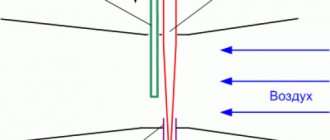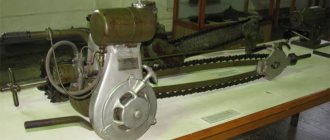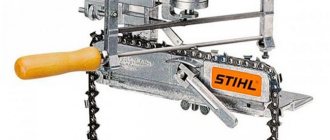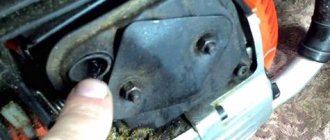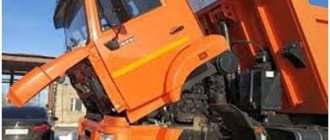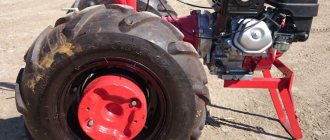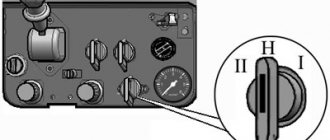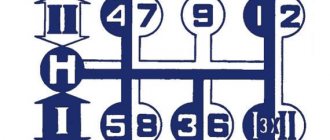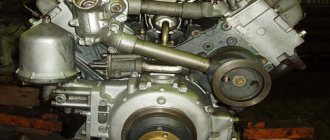A modern car is a complex set of components and mechanisms that, unfortunately, are subject to wear and tear. The steering wheel control system wears out especially quickly due to the fact that most of its components operate under extreme conditions; a malfunction occurs, such as play in the steering. First of all, you need to keep in mind that its elimination should not be shelved, since we are talking about damage associated with a danger to the lives of not only the driver and passengers, but also other road users. And so, let’s look at the reasons why this malfunction occurs, and also find out how to remove the total play in the steering column.
Steering design
The design of the steering system in modern cars is almost the same for most models produced; there are only minor differences.
- Steering wheel.
- Cardan-type intermediate joint.
- Steering gear.
- Left and right pulls.
- Internal and external tips.
- Adjustment rods.
VEHICLE LAYOUT
There are three types of car layout:
- Front-engine - a car layout in which the engine is located in front of the passenger compartment. It is the most common and has two options: rear-wheel drive (classic) and front-wheel drive. The last type of layout - front-engine, front-wheel drive - is now widely used due to a number of advantages over rear-wheel drive: - better stability and controllability when driving at high speed, especially on wet and slippery roads. — ensuring the necessary weight load on the drive wheels. - lower noise level, which is facilitated by the absence of a driveshaft. At the same time, front-wheel drive cars also have a number of disadvantages: - at full load, acceleration on hills and on wet roads is reduced; — at the moment of braking, the weight distribution between the axles is too uneven (the wheels of the front axle account for 70%-75% of the car’s weight) and, accordingly, the braking forces (see Braking properties); — the tires of the front driving steered wheels are more loaded and therefore more susceptible to wear; - drive to the front wheels requires the use of complex narrow joints - constant velocity joints (CV joints) - combining the power unit (engine and gearbox) with the main gear complicates access to individual elements.
- The mid-engine layout—the engine is located between the front and rear axles—is quite rare for passenger cars. It allows you to get the most spacious interior with given dimensions and good distribution along the axles.
- Rear-engine - the engine is located behind the passenger compartment. This arrangement was common on small cars. When transmitting torque to the rear wheels, it made it possible to obtain an inexpensive power unit and distribute such load along the axles, in which about 60% of the weight fell on the rear wheels. This had a positive effect on the vehicle's cross-country ability, but negatively on its stability and controllability, especially at high speeds. Cars with this layout are currently practically not produced.
Principle of operation
To understand what steering play is, consider the principle of operation of steering systems in a modern car. The steering wheel is connected through a cardan joint to a mechanism that is a hollow (usually duralumin) tube, inside of which there is a gear rack moved by a gear connected to the cardan joint. The rack is connected through internal tips to rods, which are connected through external hinges to the steering arms on the front suspension struts. Thus, any movement of the rack leads to the rotation of the wheels and any play in the steering can lead to serious consequences from a delayed reaction to movement to a complete loss of control of the car.
Reasons for play in the steering:
- poor tightening of the steering wheel nut;
- wear of spline joints;
- wear of the cardan joints of the intermediate shaft;
- loosening of the steering mechanism to the body;
- increased gap between the rack and gear in the mechanism;
- tip wear;
- wear of the rubber-metal hinges securing the rods to the mechanism or weakening of their fastening bolts;
- loosening the adjusting rods.
The play may be accompanied by a knocking sound in the steering column, which may indicate wear of the parts.
Signs of breakdown
Natural wear of gear joints and articulated drives occurs slowly, so it is difficult for the driver to notice at what point the backlash began to increase. To control this process, the motorist must periodically check this parameter. So, for passenger cars, the norm is when the free play of the steering wheel does not exceed 10 degrees.
When, while driving, the car slows down its response to turning the steering wheel, the driver needs to stop and check what the reason is. This is a clear sign of a breakdown.
Any squeaks, knocks, vibrations, or any deviation of the car from a given trajectory are all signs of a steering failure. Because of this, in an emergency situation, the driver may not be able to control the vehicle and cause an accident.
Permissible steering wheel play
Fearing this, some motorists generally try to eliminate the free play of the steering wheel. However, this will accelerate the wear of parts and they will need to be replaced with new ones more often than usual.
In the vehicle operation and repair manual, the manufacturer indicates the permitted steering play. If this data is missing, you should proceed from the basic requirements specified in the traffic rules.
The machine must meet the following requirements:
| Car type: | Maximum allowable backlash (in degrees) |
| Passenger car | 10 |
| Cargo | 25 |
| Bus | 20 |
As you can see, the larger the dimensions of the car, the higher the free play of the steering.
Causes of steering play
It is quite easy for a car enthusiast to independently determine the causes of backlash. To do this, you need to place the car on a flat area, open the hood, set the wheels in a position corresponding to straight-line movement and sharply turn the steering wheel in both directions at a small angle (for this you will need an assistant) and use your hand to feel all the components, due to a malfunction of which, play occurs in steering control. Your hand will immediately feel the faulty unit by the characteristic shift when the wheel rocks.
Loosening the nut
The most “harmless” reason for the appearance of acceptable play in the steering wheel is the weakening of the steering wheel fastening due to the loosening of the steering wheel fastening nut. To eliminate this malfunction, it is enough to remove its decorative trim and, using a socket wrench of the appropriate size, tighten the nut to the recommended torque. On most modern cars, an airbag module is installed in the steering wheel trim, which will need to be removed to provide access to the mounting nut. Therefore, all work must be carried out with special care, disconnecting the terminals from the battery.
Loosening the steering wheel nut leads to a more unpleasant problem - due to its rotation on the axle, the splines at the joint begin to wear out, which leads to loss of control. Repairs, which involve mandatory replacement of damaged parts, in this case must be carried out immediately. Wear of the universal joints on the intermediate shaft leads to the so-called “gear effect”, which manifests itself in the fact that when the steering wheel rotates, it periodically rubs. This malfunction leads to deterioration in vehicle controllability, especially at high speeds. In this case, it is necessary to replace the intermediate shaft.
Another reason that causes play in the steering wheel is loosening of the steering mechanism to the body or sedimentation of the rubber gaskets between the steering mechanism and the body. If this problem occurs, it is necessary to tighten the nuts securing the mechanism, or replace worn rubber parts. Increased clearance in the rack gears also does not bode well. It appears due to the deterioration of the contact surfaces of the rack and gear. Also, in this mechanism, the gaps between the rack and the guides relatively often increase. Moreover, the wear process accelerates significantly if the integrity of the protective anthers is damaged.
Wear of rod ends
Particularly dangerous is play in the steering, which is caused by wear on the outer rod ends. The rod ends are perhaps the most vulnerable point in the entire control system. This happens because they work in difficult conditions, constantly exposed to water, dirt, etc.
The seriousness of the malfunction is that the result is a significant increase in the axial and radial clearances in the ball joint of the tip, and, ultimately, it collapses, causing the car to lose control. It is not difficult to predict the consequences of such a malfunction, especially at high speed. In such cases, you must immediately contact a car repair shop to replace the tips.
The inner ends of the rods are attached to the steering mechanism through rubber-metal hinges pressed into their ends. If these joints wear out, a characteristic metallic knock is heard when turning the steering wheel. To eliminate this malfunction, you need to press new ones into the rods. This work requires the presence of pressing equipment, so it is best to carry out it in a car service center. Or the bolts securing the rods to the mechanism are unscrewed. In this case, to reduce and eliminate play, it is enough to tighten these bolts to the torque specified by the manufacturer.
Other troubles
In addition to backlash, you should be attentive to other troubles associated with turning and steering:
- Increasing effort. If you notice that you need to apply more and more force to the steering wheel in order to make a turn, then this is also a sign of a problem. This happens due to wear of the rack or gearbox.
- Spontaneous deviation. Let's assume that you parked your car in the evening, leaving the steering wheel strictly in the center. In the morning, getting into the cabin, you noticed that it was tilted, while the wheels remained straight.
- Leaks. Liquid can leak both from the rack seal and from the power steering barrel. You can find them under your car, or during a self-inspection in a pit.
If one of these aspects is detected, we recommend immediately contacting the service and checking the mechanisms. One diagnostic that you pay for can save not only your future budget, but also the health and life of you and your passengers.
How to adjust steering play
And finally, another reason for play in the steering is loosening of the adjusting rods, which are designed to adjust the toe-in of the car's wheels. This is a consequence of poor tightening of the bolts on these rods after adjusting the toe angle, and can lead to the adjusting rod popping out of the tip.
On some modern car models, the swing arms are not welded to the suspension struts, but are bolted together. The weakening of these connections also leads to the appearance of the described trouble. To exclude this option when determining the cause that led to it, you need to lift the front of the car and remove the wheels and check the tightness of the above connections, thereby adjusting the steering.
Recommendations
After completing the adjustments, the rack should also be checked while running. It is important to pay attention to the fact that after turning the steering wheel, the steering wheel itself must return to the zero position (steering wheel straight) without driver assistance. If you have to turn the steering wheel by hand (the steering wheel does not return to zero), this indicates obvious problems with the rack (too tight the adjusting nut, wedging, etc.).
We also recommend reading the article about what electric power steering is. From this article you will learn about the features, as well as the pros and cons of electric power steering.
You can accurately check this nuance on a straight section of road with a good road surface without defects. Please note that when checking you need to be careful and careful! If there is no suitable site or you are not confident in your abilities, it is better to refuse these tests.
To check the steering return, just go through a turn and, at the exit of it, press the gas, briefly removing your hands from the steering wheel. If the steering wheel does not tend to return to the zero position and needs to be turned independently, then the nut on the rack may be overtightened and needs to be loosened.
Defective parts
The parts of the disassembled rack must be wiped of oil, cleaned of deposits and carefully inspected. Repair kits usually include only rubber seals and fluoroplastic bushings with rings. This may not be sufficient for every case.
Carefully inspect the surface of the gear rod - there should be no damage or signs of wear.
Pay special attention to the working area - the teeth and the part of the rod that comes into contact with the rings, seals and bushings. Any damage, corrosion, risks and scuffing will lead to rapid wear of the seals and rack leakage
Deep corrosion of the rack rod.
Such a detail cannot be installed. There should be no cracks, nicks, chips or deep wear on the helical teeth of the drive shaft gear. It is dangerous to install a shaft with such damage - the rack may jam in motion.
A common cause of knocking noises in the rack is wear of the pressure bushing. The working surface of the part must be smooth, without signs of pressing or scoring. The pressure bushing is usually not included in the rack repair kit, but for many cars it can be purchased separately.
Wear of the pressure sleeve - the fluoroplastic insert is pressed through
Severely worn and damaged rack parts cannot be restored in a garage. If problems are found during troubleshooting, contact specialized service stations for help. There they can restore the rack shaft and rod using professional equipment.
Elimination
The fight against backlash should begin by checking and tightening all threaded connections. Often the reason is here
Particular attention should be paid to the nut securing the column to the gearbox. With frequent trips on dirt roads and worn-out asphalt, this fastener regularly becomes loose.
If you do not respond to the problem in a timely manner, you risk getting more serious steering problems. The nut may unscrew entirely, leading to complete failure of the steering. This also leads to increased wear of all parts of the mechanism.
Read more: The fuel pump on the UAZ Bukhanka does not work
Adjusting the gearbox also helps combat backlash. To do this you will have to look under the hood. There you will see a gearbox. There is an adjustment screw on it. To get to it, you will have to remove the plug. The screw is protected from turning with a 19mm locknut. It is slightly loosened with an open-end wrench. After this, adjustment is made with a screwdriver. The task is to reduce the backlash. If you can’t do this, then it’s time to change the gearbox. It's easier to do the job with two people.

